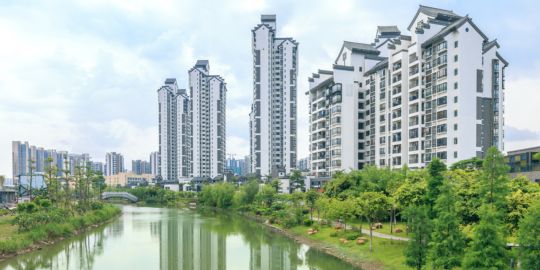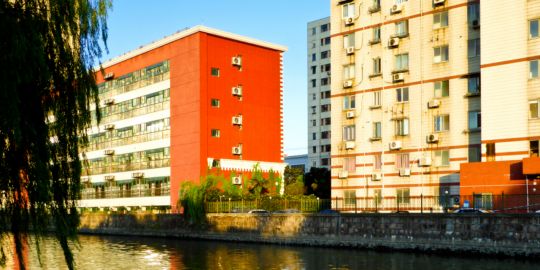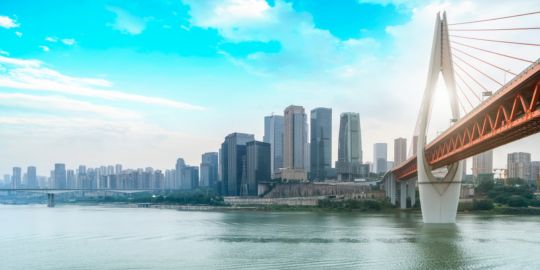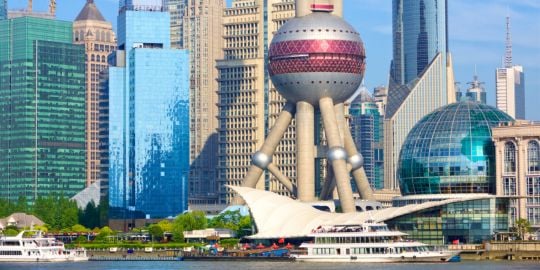Accommodation in Shenzhen
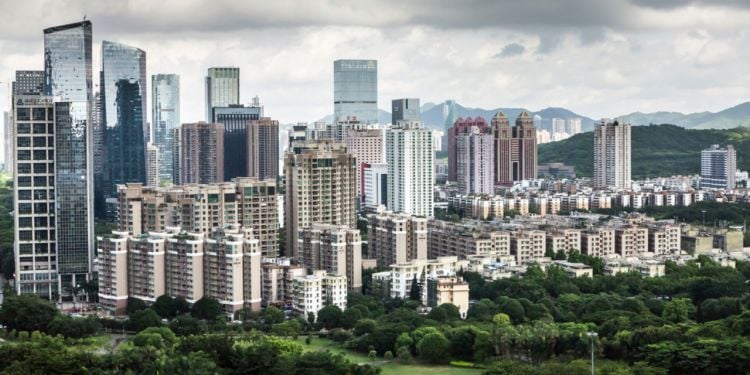
Shenzhen is one of China's youngest and fastest-growing cities. Once a small fishing village, the city has grown into one of the country's key business and financial centers and the world's leading electronics hub. The city's fast development attracts plenty of opportunity-seekers from other cities in China and abroad, and while there is no shortage of accommodation options in the city, housing prices are growing fast.
If you want to live in Shenzhen, the process of looking for a place is quite straightforward. There are plenty of real estate agencies in the city with English-speaking staff as well as international agencies who can help you find a suitable place.
Which are the best neighborhoods for expats in Shenzhen?
Shenzhen is divided into six districts: Futian, Luohu, Nanshan, Yantian, Baoan, and Longgang, and four more management areas: Pingshan, Longhua, Guangming, and Dapeng.
The city is stretched along the coast, and the distance between the districts is quite considerable. Even though the city has one of the most advanced metro systems in China, commuting to work is an important consideration. A subway trip from Nanshan on one end and Luohu on the other can take you over an hour. Thus if you don't particularly enjoy public transportation travel, you will need to choose your district wisely.
Futian, Luohu, and Nanshan are the city's main central districts and the epicenters of all commercial, financial, and residential activity.
Futian is the city's central business district, home to some of the most influential companies, office buildings, shopping malls, entertainment areas, and more. It's especially popular with young expats who don't want to miss out on the action and have the city's best nightclubs and shopping areas within a short cab ride.
Luohu is the oldest and busiest city district. It's home to some of Shenzhen's biggest shopping malls as well as the famous SEG Electronics Market. There are some modern residential complexes in Luohu, but most of the buildings cater more to residents. Expats who live in Luohu typically choose the district because of its proximity to the SEG Electronics market and other wholesale shopping areas.
Nanshan is primarily a residential district. It's much quieter and greener than Luohu and Futian, and a favorite residence option for both locals and foreigners. Nanshan is also home to a mini sub-district Shekou, also known as the 'expat village'. Located at the edge of Nanshan, it's a coastal area with many modern high-rises, a famous international entertainment hub, foreign shops and restaurants, and Shekou port connecting the city with Hong Kong and Macau.
Baoan is a new up-and-coming district. Though located a bit far from central areas, it's being actively built up. Yantian is situated beyond Luohu and is a busy industrial area but also houses Shenzhen's biggest beach, Dameisha. Many expats choose to settle here to enjoy beach life throughout the year.
What types of accommodation are available in Shenzhen?
There is an abundance of housing options in Shenzhen. From luxury penthouses and villas to serviced apartments and studios, you are sure to have a lot of choices. As Shenzhen is a very young city, most of the buildings are relatively new as well. What's more, due to the continually increasing urban population, more and more residential complexes are being built in the city. In fact, Shenzhen is one of the busiest cities in China regarding housing construction.
In Shenzhen, you will find both modern western-style and traditional Chinese-style apartments.
Note with a traditional Chinese-style apartment, there are a few things you need to be aware of. First, if you rent an apartment in an older building, your place will most likely have a squat toilet. This may take some adjustment, but apartments with a squat toilet are generally cheaper, so the adjustment may be worth the savings.
Chinese apartments generally have rather small rooms. The kitchen area is also quite miniature. Most kitchens in China won't have an oven or a dishwasher. Most apartments are equipped with gas, but in some cases, you may need to use an electric cooker. You won't find bathtubs in most apartments in Shenzhen unless you are renting something very expensive. Most apartments come with balconies. However, balconies can be quite small, and most families in China use them for drying clothes and storage rather than as a place to enjoy the views from.
Your choice of accommodation in Shenzhen, of course, will depend on your family situation, the length of your stay, and budget considerations.
Rent prices in Shenzhen
Rent prices in Shenzhen are notoriously high. A recent survey earmarked Shenzhen and Shanghai as two of the five fastest-growing property markets worldwide. It could be the city's proximity to Hong Kong or its rapid economic development, but as one of China's youngest cities, it is also one of its most expensive. This is why many expats (especially at the beginning of their careers) choose to rent shared accommodation or studio apartments.
To rent a studio apartment in one of the popular districts in Shenzhen, you will need at least RMB 4,000. And to rent a well-furnished one-bedroom in the city center or one of the popular expat areas, you may need around RMB 8,000. If you are looking to live in one of the expat-famous residential complexes in Shekou, you may need at least RMB 10,000 to move into a standard one or two-bedroom place. Large places or penthouses can cost you 20,000 RMB a month.
Naturally, the further you venture away from expat areas, central districts and metro lines, the higher your chances are of finding less expensive places. The new up-and-coming district of Baoan offers more affordable housing compared to other districts.
In addition to what you pay in rent, you will also need to factor in additional fees. These may include:
Maintenance fees: Many residential complexes in Shenzhen have maintenance fees. These fees cover security guards' salaries, ground maintenance, landscaping, trash pickup, etc. They are typically calculated based on the square footage of the apartment.
Utilities: With most rental agreements, utilities are not included in your rent and need to be paid separately. How much you spend depends on how much water and electricity you use per month. Your utility bill in Shenzhen may be anywhere between RMB 200 ($30) to RMB 500 ($74) per month. Note that it gets very hot in the city in summer, and your air conditioning will probably be on for long periods of time.
Parking fees: If you have a vehicle and need a parking space, you will (most likely) need to pay for it separately. If you are renting in a residential complex, your apartment may come with a dedicated parking space.
How to pay utility bills in China?
Utilities in China generally work on a pre-paid basis. You will need to use a special
rechargeable card to top off your balance at a utility meter, bank and other locations. You can check with your landlord about the nearest locations to pay your utilities. Make sure not to lose your utility cards, as these can be quite difficult to replace.
If you find this system confusing, you may also be able to arrange an agreement with your landlord: they will pay for utilities on your behalf, and your utility bill will be added to your monthly rent.
If you live in a gated residential community with a management office or concierge, you may also be able to pay your utilities there. This will make things much easier, especially if you are new to China and have trouble navigating the local system.
How to find accommodation in Shenzhen?
You can start your apartment hunt in Shenzhen online by checking out websites like ForeignerCN, Anjuke, NowShenzhen, etc. You can also check expat groups in the city like Shenzhen Expats Group and others for apartment or room offers.
Most apartment adts will indicate how big the apartment is, where it is located, rent conditions (deposit amount), and whether the ad has been posted by a real estate agent or the owner. If you are interested in taking a look at the place, message the post's author with your contact details. In China, the most popular way to communicate online is by using the WeChat app. The app has over 900 million users and is the number one tool you will need for your everyday life in China. WeChat is primarily a messenger app, but you can also use it for shopping online, paying for goods and services via the QR code, and more.
Once you get in touch with a real estate agent or your potential new landlord, they will probably ask you for your WeChat ID. This is why it's a good idea to download the app and learn how to use it before you start your apartment hunt in Shenzhen.
Another way to look for apartments in the city is by visiting different districts and neighborhoods. Once you have found the location you like, you should easily find a real estate agency office nearby. The agency will probably specialize in the accommodation offers in the area, so you will have a better chance of renting an apartment in the area you prefer. If you're looking to rent in gated residential communities, you may also ask the “baoan” (security guard) for any available rentals. The baoan can put you in touch with landlords renting out apartments in the complex.
Important:
Renting accommodation directly from the landlord will help you avoid extra costs such as the agent's finders fee. However, if you're new to Shenzhen, don't speak Chinese, and are not yet familiar with how things work in the housing market, it will be in your best interest to rent an apartment through a real estate agent. This way, you will have someone experienced representing your interests. Plus, in case of a dispute with your landlord, you will be able to turn to your real estate agent to help resolve it.
Lease agreements in Shenzhen
You will need to pay attention to several things when signing the lease agreement in Shenzhen:
- Most rental agreements are written in Chinese. Some will have a shorter English version attached or a translation line under each line in Chinese. If your rental agreement is written entirely in Chinese, get a translator to provide you with an English copy. Never sign any contract in Chinese if you don't understand the meaning of every clause. Even if your contract comes with an English translation, it may be best to have a translator give it another look just to ensure that the original translation is accurate.
- If you are new to Shenzhen, it's best to have a Chinese friend or colleague present when you sign the lease. This way, you will be able to efficiently address any issues that may come up during the signing. Your Chinese friend will also have a better understanding of what to look out for when signing the lease.
- When you sign the rental agreement in Shenzhen, like anywhere else in China, there will be an inventory of all the items in the apartment attached to the contract. This includes Furniture, appliances, decoration, and so on. Make sure to give the apartment a proper walk-through and check if all the items on the list are there. If you notice that anything is missing, let the landlord or the real estate agent know. This is the best way to avoid any future disputes with the landlord when you have to move out.
- Make sure to check the apartment for any damage or wear. If you notice any anomalies, it's a good idea to take a picture of them and show them to the landlord or real estate agent before signing the lease.
- You will most likely be asked to pay a two-month deposit when you rent an apartment. If you rent a place via a real estate agent, you will also need to pay the agent's fee, which usually amounts to half a month's rent. Make sure to keep your deposit receipts till the end of your lease. You will need them to get your deposit back at the end of your stay.

